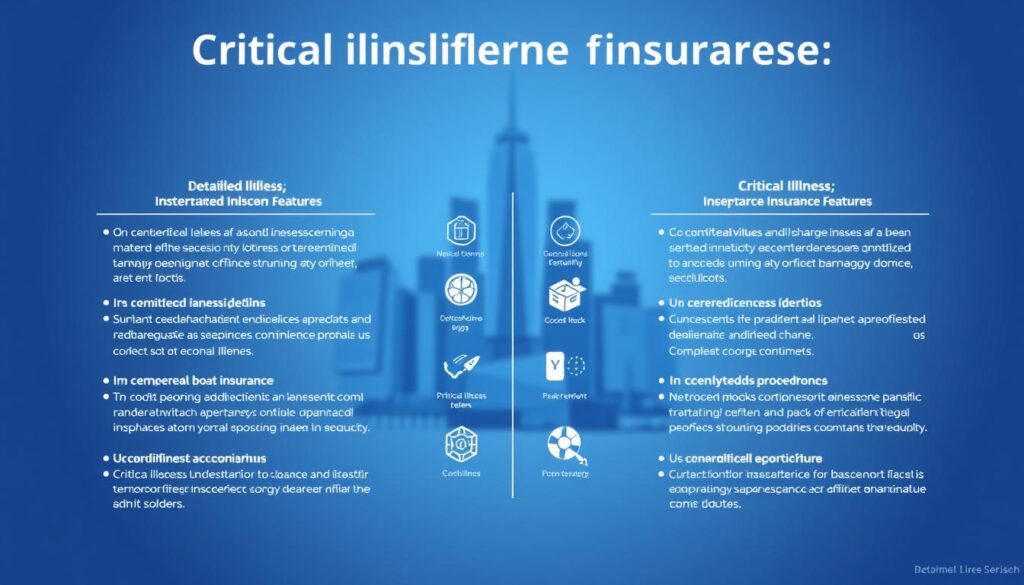Choosing the right protection plan is essential for safeguarding your health and financial well-being. In 2024, several standout options offer comprehensive coverage tailored to meet diverse needs. These plans include multi-pay options, flexible premiums, and coverage for various stages of health concerns.
Leading providers like Singlife and Tokio Marine bring unique features to the table. For instance, Singlife offers a payout potential of up to 900%, while Tokio Marine ensures claims without waiting periods. These features make them top contenders in the market.
It’s crucial to select a plan that aligns with your personal or family medical history. The Life Insurance Association (LIA) of Singapore’s 37 critical illness framework serves as a reliable guide for understanding coverage standards. This ensures you’re well-protected against a wide range of health challenges.
Key Takeaways
- Explore top-rated plans with multi-pay options and flexible premiums.
- Singlife offers a payout potential of up to 900%.
- Tokio Marine provides claims without waiting periods.
- Match your plan to your personal or family medical history.
- Refer to the LIA’s 37 critical illness framework for industry standards.
Why Critical Illness Insurance is Essential in Singapore
Facing a major health condition can be overwhelming, especially without proper financial safeguards. In Singapore, where healthcare costs are rising, having a solid plan in place is crucial. This is where critical illness insurance steps in, offering a safety net during challenging times.
Financial Protection Against Major Illnesses
Serious health conditions like cancer or heart disease can lead to significant expenses. For example, private hospital cancer treatment can cost between $100,000 and $300,000. Without adequate coverage, these costs can deplete savings quickly.
Critical illness insurance provides a lump sum payout to help cover these expenses. For instance, a $300,000 payout can replace two years of income, allowing you to focus on recovery without financial stress. This protection ensures you’re prepared for the unexpected.
Rising Healthcare Costs in Singapore
Healthcare expenses in Singapore are increasing by 7.2% annually, according to 2023 MOH data. ICU stays alone can cost between $4,000 and $8,000 per day. These rising costs make it essential to have a plan that covers such conditions.
With the average Singaporean needing $316,000 in coverage, critical illness insurance bridges the gap. It ensures you’re not burdened by medical bills during a health crisis. This financial safety net is invaluable for peace of mind.
Understanding Critical Illness Insurance
Understanding how protection plans work can help you make informed decisions about your health and finances. These plans provide a safety net during unexpected health challenges, ensuring you’re prepared for the unexpected. Let’s break down what these plans offer and their key features.
What is Critical Illness Insurance?
A critical illness plan is designed to provide financial support when you’re diagnosed with a serious health condition. It offers a lump-sum payout upon diagnosis, which can be used for medical expenses, experimental treatments, or even daily living costs. For example, a $250,000 payout could cover experimental cancer treatments not covered by standard health plans.
Most plans require a 14-30 day survival period after diagnosis to qualify for the payout. This ensures the policy is activated only for confirmed cases. The sum assured is the full amount you’ll receive, often 100% of the coverage amount.
Key Features of Critical Illness Plans
Modern critical illness plans come with features tailored to meet diverse needs. Multi-pay plans, for instance, allow claims up to 900% of the sum assured, providing multiple payouts for different stages of a condition. Single-pay plans, on the other hand, offer a one-time lump-sum payout.
Here’s a comparison of single-pay and multi-pay structures:
| Feature | Single-Pay Plan | Multi-Pay Plan |
|---|---|---|
| Payout Structure | One-time lump sum | Multiple payouts (up to 900% of sum assured) |
| Coverage | Full sum assured at diagnosis | Staggered payouts for different stages |
| Flexibility | Limited | High |
When choosing a plan, consider these five must-have features:
- Flexible payout options (lump-sum or staggered).
- High sum assured to cover major expenses.
- Multi-pay options for extended coverage.
- No waiting periods for claims.
- Clear terms for survival periods.
Best Critical Illness Insurance Plans in Singapore
Navigating the options for health protection can feel overwhelming, but knowing the top plans simplifies the process. Whether you’re looking for comprehensive coverage or focused protection, there’s a plan tailored to your needs. Let’s explore some of the standout options available in 2024.
Singlife Comprehensive Critical Illness
Singlife offers a robust critical illness plan with a payout potential of up to 900%. This plan covers 132 conditions, including a $25,000 ICU benefit. It’s ideal for those seeking extensive coverage and flexible payout options.
Tokio Marine TM MultiCare
Tokio Marine’s MultiCare plan provides $350,000 in early-stage coverage. It also includes protection for 10 juvenile conditions, making it a great choice for families. The no-waiting-period feature ensures quick access to payouts when needed.
Etiqa 3 Plus Critical Illness
Etiqa’s 3 Plus plan stands out with its affordability, offering premiums as low as $0.24 per day. It also covers up to four children for free, making it a cost-effective option for young families.
Feature Comparison Table
| Feature | Singlife Multipay | Tokio Marine MultiCare | Etiqa 3 Plus |
|---|---|---|---|
| Coverage Limits | Up to 900% sum assured | $350,000 early-stage | Affordable premiums |
| Unique Benefits | ICU $25k benefit | 10 juvenile conditions | Covers 4 children free |
Expert Tip
When choosing a policy, consider whether you need comprehensive coverage or a focused plan like the Big 3. Comprehensive plans offer broader protection, while focused plans are more budget-friendly.
Case Study: Tokio Marine’s No-Waiting-Period
One policyholder shared how Tokio Marine’s no-waiting-period feature helped them receive a payout immediately after diagnosis. This quick access to funds allowed them to focus on recovery without financial stress.
By understanding the features of these top plans, you can make an informed decision that aligns with your health and financial goals.
Comparing Critical Illness Insurance Plans
Selecting the right health protection plan requires careful comparison of features and benefits. With various options available, understanding the differences in coverage, premiums, and waiting periods can help you make an informed decision. Let’s dive into the key aspects to consider when evaluating these plans.

Coverage and Benefits
Different plans offer varying levels of coverage. For example, HSBC Super CritiCare provides a $350,000 early-stage cap, making it ideal for those seeking immediate financial support. On the other hand, AIA Beyond Critical includes mental health coverage, addressing a broader range of health concerns.
When comparing benefits, look for features like multi-pay options or additional perks such as premium refunds. AIA Beyond Critical, for instance, offers a 20% premium refund, adding extra value to the plan.
Premiums and Payouts
Premiums can vary significantly based on the plan’s coverage and benefits. It’s essential to balance affordability with the level of protection you need. Use an interactive calculator to explore how premiums change with different coverage durations.
Payouts are another critical factor. Some plans offer a lump-sum payout, while others provide staggered payments. Multi-pay plans, for example, allow multiple claims, ensuring continuous financial support during treatment.
Waiting Periods and Survival Periods
Waiting periods can impact how quickly you can access your payout. HSBC Super CritiCare has a 24-month cancer relapse waiting period, which may influence your decision if you’re at higher risk. Survival periods, typically 14-30 days, ensure the policy is activated only for confirmed cases.
Understanding these periods is crucial to avoid delays in receiving your payout. Always review the terms to ensure they align with your needs.
- Interactive calculator: Compare premiums and coverage duration scenarios.
- Infographic: Visualize the impact of waiting periods on different age groups.
- Comparison: Analyze traditional vs. multi-pay plan cost structures.
- Claim statistics: Learn about common denied claims and how to avoid them.
- Expert analysis: Discover the best value plans for smokers vs. non-smokers.
Key Considerations When Choosing a Plan
Making the right choice for your health protection involves understanding key factors that impact your coverage. From the stage of protection to the type of payout structure, each decision plays a role in ensuring you’re adequately covered. Let’s explore the essential elements to consider when selecting a plan.
Early, Intermediate, or Late-Stage Coverage
One of the first decisions is choosing the stage of coverage you need. Early-stage plans focus on initial diagnoses, while late-stage options provide support for advanced conditions. Intermediate plans bridge the gap, offering balanced protection.
Keep in mind that early-stage plans typically cost 40-60% more than late-stage-only options. This is because they provide broader financial support from the onset of a health concern. Consider your family history and risk factors when deciding which stage suits you best.
Single vs Multi-Pay Plans
Another critical factor is the payout structure. Single-pay plans offer a one-time lump sum, while multi-pay options allow multiple payouts for different stages of a condition. Multi-pay premiums are often 2-3 times higher than single-pay equivalents, but they provide extended financial support.
For example, a multi-pay plan might cover initial treatment, recovery, and relapse, ensuring continuous financial assistance. This flexibility can be invaluable during prolonged health challenges.
Coverage Period and Sum Assured
The duration of your coverage and the sum assured are also crucial. Longer coverage periods ensure protection over time, while a higher sum assured provides greater financial security. Use a calculator to determine the ideal amount based on your income, debts, and dependents.
Be cautious of underinsuring early-stage conditions, as this can leave you financially vulnerable. Additionally, high sum assured payouts may have tax implications, so consult a financial advisor for guidance.
- Decision flowchart: Choose coverage stages based on family history.
- Case comparison: Optimal coverage periods for a 35-year-old vs a 50-year-old.
- Calculator: Determine the ideal sum assured based on your financial situation.
- Expert warning: Avoid underinsuring early-stage conditions.
- Tax implications: Understand the impact of high sum assured payouts.
How Much Critical Illness Coverage Do You Need?
Determining the right amount of financial protection for your health is a crucial step in securing your future. It ensures you’re prepared for unexpected challenges without compromising your financial stability. Let’s explore how to assess your needs and the factors that influence your coverage amount.

Assessing Your Financial Needs
Start by evaluating your current financial situation. The Life Insurance Association (LIA) recommends a sum assured of 3.9 times your annual income, which averages $316,000 in Singapore. This ensures you have enough funds to cover medical expenses and maintain your lifestyle during recovery.
Consider your debts, such as mortgage loans, which average $500,000 among homeowners. Add these to your income calculation to determine the total coverage you need. For example, if you earn $80,000 annually, your sum assured should be around $316,000 plus your outstanding debts.
Factors Influencing Coverage Amount
Several factors can impact the amount of coverage you require. Your family’s medical history, the number of dependents, and future inflation rates all play a role. For instance, treatment costs are projected to rise significantly by 2030, so it’s wise to account for this in your plan.
Use a 4-step calculation to determine your needs: multiply your income by 3, add your debts, and include a medical buffer. Tools are available to adjust for dependents or loans, ensuring your sum assured is tailored to your situation.
- Interactive tool: Adjust your coverage based on dependents and loans.
- Case study: Learn how one individual adjusted their plan after purchasing a property.
- Inflation projection: Estimate future treatment costs to ensure adequate protection.
- Expert tip: Coordinate your coverage with existing health plans for comprehensive protection.
Standalone vs Rider Critical Illness Plans
Deciding between standalone and rider plans can shape your financial security in different ways. Each option has its unique benefits and drawbacks, making it essential to understand which aligns best with your needs. Let’s explore the key differences to help you make an informed choice.
Pros and Cons of Standalone Plans
Standalone plans offer comprehensive cover for critical health conditions. They are independent of other insurance policies, providing flexibility and dedicated protection. However, they come with higher premiums, averaging $120-$300 per month.
One major advantage is the full sum assured payout, which isn’t tied to a life policy. This ensures you receive the full amount without affecting other cover. On the downside, the cost can be a barrier for some individuals.
Pros and Cons of Riders
Riders are add-ons to existing life or term policies, costing 30-50% less than standalone plans. They are a budget-friendly option but reduce the overall life coverage. For example, claiming a rider payout can decrease the death benefit of your policy.
Riders are ideal for those who want additional protection without purchasing a separate policy. However, they may not provide the same level of flexibility or comprehensive cover as standalone plans.
- Cost comparison: Riders save money upfront but may limit long-term benefits.
- Case study: A rider claim reduced a whole life policy’s death benefit by 40%.
- Checklist: Riders make sense for those with existing life policies.
- Insurer spotlight: Some providers offer integrated rider programs with added perks.
- Regulatory update: 2024 LIA changes may affect rider terms and conditions.
Understanding the 100% Sum Assured
Understanding the concept of sum assured is key to maximizing your financial protection. It represents the guaranteed amount you’ll receive under your plan, ensuring you’re adequately covered during challenging times. Let’s break down what this means and how it works.

What Does 100% Sum Assured Mean?
The 100% sum assured is the full amount you’re entitled to receive upon meeting the plan’s conditions. For example, if your sum assured is $200,000, you’ll receive this amount as a lump-sum payout when a covered condition is diagnosed. This ensures you have immediate financial support for medical expenses or other needs.
It’s important to note that some plans may require a survival period, typically 14-30 days, to activate the payout. This ensures the policy is only triggered for confirmed cases, providing clarity and security for policyholders.
Enhanced Payouts: 200% to 500% Sum Assured
Some plans go beyond the standard 100% sum assured, offering enhanced payouts for specific conditions. For instance, Singlife Big 3 provides a 200% sum assured for cancer, heart disease, or stroke. This means a $200,000 sum assured could result in a $400,000 payout for these conditions.
China Taiping takes it a step further, offering up to 500% sum assured for rare conditions. This extended benefit ensures you’re fully protected even in the most challenging scenarios. Such enhanced payouts can make a significant difference in covering advanced treatments or long-term care.
- Visual guide: How sum assured compounds in multi-pay plans.
- Case comparison: $100k vs $200k base sum assured.
- Tax implications: Understand the impact of large lump-sum payouts.
- Expert warning: Avoid overinsurance risks.
- Historical data: Trends in sum assured from 2015 to 2024.
Critical Illness Insurance for Families
Families need tailored protection to ensure everyone’s well-being. A comprehensive plan not only safeguards parents but also extends cover to children, providing peace of mind during challenging times. With rising healthcare costs, securing a policy that meets your family’s needs is more important than ever.
Protecting Your Loved Ones
When it comes to family health, unexpected challenges can arise at any time. A robust policy ensures that your loved ones are financially protected if a serious condition is diagnosed. For example, Etiqa offers free cover for up to four children, with benefits extending up to $300,000. This makes it an excellent choice for families seeking comprehensive protection.
Child Coverage and Special Conditions
Children have unique health needs, and some plans address these with specialized benefits. Juvenile conditions covered include Kawasaki disease, pediatric cancer, and other serious illnesses. These plans ensure that your child receives the care they need without straining your finances.
Here’s a comparison of top child-friendly plans:
| Feature | Etiqa 3 Plus | Tokio Marine MultiCare | Singlife Multipay |
|---|---|---|---|
| Child Coverage | Up to 4 children free | 10 juvenile conditions | ICU $25k benefit |
| Maximum Benefit | $300,000 | $350,000 | Up to 900% sum assured |
Case Study: One family shared how their policy helped them cover pediatric cancer treatment costs. The quick payout allowed them to focus on their child’s recovery without financial stress.
Special needs planning is also essential. Some plans offer riders for autism or ADHD, ensuring comprehensive cover for children with unique requirements. Additionally, school program partnerships often provide discounts, making these plans more accessible.
For more insights on family-focused plans, visit this guide.
Frequently Asked Questions About Critical Illness Insurance
Many people have questions about how financial protection plans work and what they offer. Here, we address some of the most common queries to help you make informed decisions.
Is Critical Illness Insurance Worth It?
Financial protection plans provide a safety net during unexpected health challenges. With rising healthcare costs, having a plan ensures you’re prepared for medical expenses. According to the Life Insurance Association, a working adult should have coverage of approximately four times their annual income.
These plans are especially valuable if you have dependents or significant financial obligations. The lump-sum payout can cover treatments, daily living costs, or even experimental therapies not covered by standard health plans.
Can You Claim Multiple Times?
Some plans allow multiple claims, offering extended financial support. For example, Singlife Multipay Critical Illness II allows up to six claims. Multi-pay plans are ideal for those who want continuous coverage during prolonged treatments.
Here’s a comparison of single-pay and multi-pay options:
| Feature | Single-Pay Plan | Multi-Pay Plan |
|---|---|---|
| Number of Claims | One-time lump sum | Up to six claims |
| Flexibility | Limited | High |
What Happens to Your Policy After a Claim?
After a claim, your policy may still remain active depending on the terms. For instance, some plans allow renewals, with a 72% renewal rate post-claim. However, the coverage amount or premiums may be adjusted based on the claim history.
It’s important to review your policy details to understand how claims affect future coverage. Some plans also offer portability, allowing you to switch insurers without losing benefits.
- Pre-existing conditions must be disclosed during application.
- The claim process typically takes 14-30 days from diagnosis to payout.
- Common exclusions include complications from cosmetic surgery.
- GIO plans have a 90% claim approval rate compared to private plans.

How to Apply for Critical Illness Insurance in Singapore
Applying for financial protection is a straightforward process when you know what to expect. Whether you’re seeking a plan for yourself or your family, understanding the steps and requirements ensures a smooth experience. Let’s break down the process to help you get started.
Steps to Get Covered
First, research and compare different policies to find one that suits your needs. Many providers offer online tools to help you evaluate options. Once you’ve chosen a plan, complete the application form, which typically includes personal and health details.
Next, you’ll undergo medical underwriting. This step involves health checkups to assess your eligibility. Common checks include BMI and blood pressure thresholds. After approval, you’ll receive your policy documents and can start your cover.
Documents and Requirements
To apply, you’ll need specific documents. These include your NRIC, recent health checkup results, and financial statements. Some providers may also request additional information depending on your chosen term and cover amount.
Here’s a quick checklist of what to prepare:
- NRIC or passport for identification.
- Health checkup results (if required).
- Proof of income or financial statements.
- Completed application form.
Insider Tip: Improving your application approval chances is easier when you’re prepared. Ensure all documents are up-to-date and accurate. If you’re unsure about any requirements, contact the provider for clarification.
Once approved, you’ll enter a cooling-off period. This allows you to review your policy and make changes if needed. It’s a great opportunity to ensure your cover aligns with your expectations.
By following these steps and preparing the necessary documents, you can secure your financial protection with confidence. Start today to safeguard your future and enjoy peace of mind.
Conclusion
Securing the right financial safety net is a proactive step toward peace of mind. Whether you’re in your 30s, 40s, or 50s, there’s a plan tailored to your life stage. For younger individuals, multi-pay options offer flexibility, while older adults may benefit from comprehensive coverage.
With rising rates of critical illness among those under 50, acting now is essential. Start by asking agents about waiting periods, payout structures, and renewal terms. These questions ensure you choose a plan that aligns with your needs.
Looking ahead, premiums are expected to increase in 2025 due to healthcare inflation. Don’t wait—book your medical checkup today to secure your policy. Taking these steps today ensures you’re prepared for whatever tomorrow brings.


